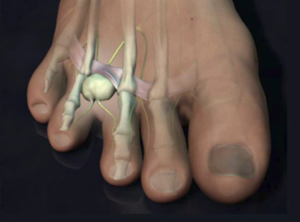COMMON CONDITIONS
Neuroma | Morton’s Neuroma | Causes of Neuroma | Neuroma Treatment IN RICHARDSON, DALLAS, GARLAND, WYLIE, MURPHY.
What is a Morton’s Neuroma?
A neuroma is a thickening of nerve tissue that may develop in various parts of the body. The most common neuroma in the foot is a Morton’s neuroma, which occurs between the third and fourth toes. It is sometimes referred to as an intermetatarsal neuroma. Intermetatarsal describes its location in the ball of the foot between the metatarsal bones. Neuroma of foot may also occur in other locations in the foot. Usually, you will have morton’s neuroma between 3rd and 4th toe.

Causes of Neuroma:
There are different causes of morton’s neuroma. One of the causes is the thickening of the nerve due to compression and irritation of the nerve. This compression creates enlargement of the nerve, eventually leading to permanent nerve damage. Neuroma in feet may occur due to wearing tight and pointy shoes. Sports activities like running also lead to the disorder.
Symptoms of Neuroma in Foot:
If you have Morton’s neuroma, you may have one or more of these symptoms:
- Tingling, burning, or numbness which may feel like you have a tiny stone under your foot. This is usually felt in the 3rd and 4th toes.
- Pain in the foot
- A feeling that something in the shoe or a sock is bunched up
Morton’s neuroma reviews show that the progression of Morton’s neuroma often follows this pattern:
- The symptoms begin gradually. At first, they occur only occasionally when wearing narrow-toed shoes or performing certain aggravating activities.
- The symptoms may go away temporarily by removing the shoe, massaging the foot or avoiding aggravating shoes or activities.
- Over the time, the symptoms progressively worse and may persist for several days or weeks.
- The symptoms become more intense as the neuroma enlarges and the temporary changes in the nerve become permanent.
What should you do if you have morton’s neuroma:
You can apply following steps for relaxing a bit before consulting a physician.
- You need to rest and raise your foot.
- Take some anti-inflammatory medications.
- Try to wear soft shoes. The best shoes for neuroma sufferers are wide and comfortable.
- Use a soft insole inside your shoes.
If you don’t get relief after performing the above steps and are still in severe pain then consult a physician.
Treatment of Neuroma in Foot:
The disorder of neuroma need to be treated as soon as possible. The neuroma treatment approaches vary according to the severity of the problem.
- Orthotic devices: Custom orthotic devices provided by your foot and ankle surgeon provide the support needed to reduce pressure and compression on the nerve.
- Activity modifications: Activities that put repetitive pressure on the neuroma should be avoided until the condition improves.
- Shoe modifications: Wear shoes with a wide toe box and avoid narrow-toed shoes or shoes with high heels. .
- Medications: Oral nonsteroidal anti-inflammatory drugs (NSAIDs), such as ibuprofen, may be recommended to reduce pain and inflammation.
- Injection therapy: For instant relief and neuroma treatment, injectibles are used. Treatment may include injections of cortisone, local anesthetics or other agents. These can often times cause the neuroma to shrink.
In some cases, surgery may be advised in patients who have not responded adequately to nonsurgical treatments. Surgery will most often completely eliminate the pain. Our physicians at Texas Foot and Ankle Consultants will determine the approach that is best for your condition. The length of the recovery period will vary depending on the procedure performed.
Neuroma | Morton’s Neuroma | Causes of Neuroma | Neuroma Treatment IN RICHARDSON, DALLAS, GARLAND, WYLIE, MURPHY.
Dr. Raymond Delpak works with patients to determine the best course of action for treating foot and ankle problems. We use the most advanced techniques possible. If you would like to learn more, please visit us TX Foot and Ankle Consultants or schedule an appointment.
SUBSCRIBE TO OUR NEWSLETTER
*for updates on our medical equipment only

